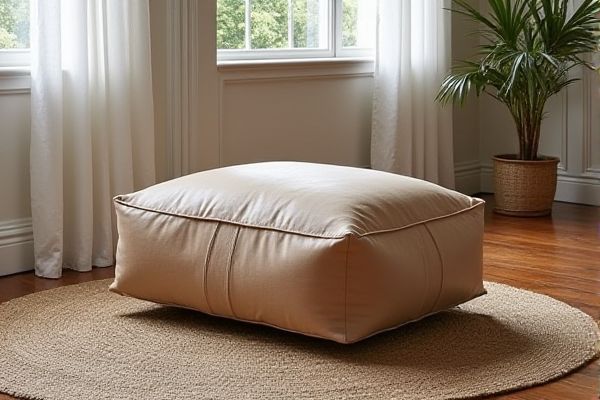
A pouf and a storage ottoman both serve as versatile seating options, but a pouf is typically lightweight, cushioned, and used mainly for casual seating or footrest purposes, while a storage ottoman offers hidden compartments to store items, combining practicality with comfort. Explore the rest of the article to discover which piece best suits your space and lifestyle needs.
Table of Comparison
| Feature | Pouf | Storage Ottoman |
|---|---|---|
| Functionality | Seating or footrest | Seating, footrest, and storage |
| Storage | No internal storage | Provides hidden storage space |
| Design | Lightweight, often fabric or knitted | Heavier, upholstered with hinged lid |
| Size | Compact, easy to move | Larger due to storage compartment |
| Usage | Casual seating, decorative accent | Practical storage and seating solution |
| Price Range | Generally affordable | Varies, usually higher due to storage |
Introduction to Poufs and Storage Ottomans
Poufs and storage ottomans both serve as versatile furniture pieces that combine style and function in any living space. Poufs are typically cushioned, upholstered seats without internal storage, ideal for extra seating or footrests. Storage ottomans feature a hollow interior, allowing you to store blankets, magazines, or other household items while also providing seating or a surface for your living area.
Key Differences: Pouf vs Storage Ottoman
Poufs are typically lightweight, cushioned seats without any internal storage, designed primarily for comfort and style, while storage ottomans double as both seating and functional storage compartments. Poufs often feature soft, fabric exteriors that contribute to a relaxed vibe, whereas storage ottomans are bulkier, with hinged or removable tops to access the storage space inside. Understanding these key differences helps you choose the perfect piece for your living space, balancing aesthetics and practical storage needs.
Design and Aesthetics Comparison
Poufs typically feature soft, rounded shapes with fabric or knitted covers that add a cozy, casual aesthetic to any space. Storage ottomans combine sleek, structured designs with functional lids that seamlessly conceal compartments, blending utility with a modern, polished look. The choice between the two depends on whether softness and informal charm or streamlined functionality and storage capacity are prioritized in interior design.
Functionality and Practical Uses
A pouf primarily serves as a versatile seating option or footrest, offering lightweight portability and adding style to any room. Storage ottomans combine comfort with practicality by providing hidden compartments for organizing items such as blankets, magazines, or toys, maximizing space efficiency. Your choice depends on whether you prioritize simple seating or the added benefit of discreet storage.
Comfort and Support Features
Poufs generally offer lightweight, cushioned seating that provides moderate comfort but minimal structural support, making them ideal for casual, short-term use. Storage ottomans deliver enhanced comfort with thicker padding and sturdy construction that supports longer sitting sessions while doubling as practical storage solutions. Your choice between a pouf and a storage ottoman should consider the balance between comfort needs and multifunctional use in your living space.
Storage Capacity and Organization
Storage ottomans offer significantly larger storage capacity compared to poufs, often featuring spacious interiors designed to hold blankets, toys, or magazines, enhancing home organization. Poufs provide minimal or no storage, serving primarily as seating or footrests without the functional benefit of concealed compartments. Choosing a storage ottoman maximizes space efficiency by combining seating with practical storage solutions, ideal for keeping living areas tidy.
Material and Durability Factors
Poufs are often made from lightweight materials such as cotton, wool, or faux leather, offering moderate durability best suited for occasional seating or footrests. Storage ottomans, constructed with sturdier frameworks like hardwood and covered in durable fabrics or leather, provide enhanced durability to support storage functions and frequent use. Material choice directly impacts the longevity and multifunctional utility of both furniture types, with storage ottomans typically ensuring greater structural integrity.
Space-Saving and Versatility
Poufs provide a compact seating option that can easily fit into small spaces, while storage ottomans offer the added benefit of hidden compartments to store blankets, magazines, or other household items. Storage ottomans maximize your living area by combining seating and storage, making them ideal for saving space in apartments or smaller rooms. Choosing between a pouf and a storage ottoman depends on whether you prioritize minimal seating or multifunctional furniture that enhances both organization and comfort.
Choosing the Right Option for Your Home
A pouf provides stylish, lightweight seating that effortlessly complements your home decor, while a storage ottoman offers practical space to organize blankets, toys, or other items, enhancing home functionality. Your choice depends on whether you prioritize versatile storage solutions or casual, portable seating. Selecting the right option ensures optimal use of space and enhances the comfort of your living area.
Conclusion: Which Is Best for You?
A pouf offers lightweight, versatile seating ideal for small spaces, while a storage ottoman combines comfort with functionality by providing hidden storage for blankets, toys, or magazines. Your choice depends on whether you prioritize extra seating simplicity or the added benefit of organized storage. For maximizing space efficiency, a storage ottoman is often the best option.
 homyna.com
homyna.com